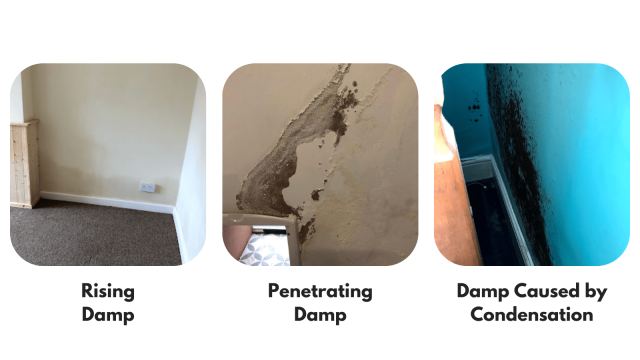What is damp?
Damp is a term used to describe the effects of moisture build-up on the surface and within the walls of a property. This can lead to various levels of damage, ranging from simple cosmetic problems to more serious issues.
There are different types of damp, and it is important to differentiate between them to be able to rectify any problems and prevent further complications.
Below, we will help you understand the main types of damp, their causes and how you can prevent damp and the damage it can do.
What are the main types of damp?
There are three main types of damp: rising, penetrating and damp caused by condensation.

Rising damp
Rising damp can often be identified by its location. If you can see patches at the bottoms of your walls, or find your skirting boards are wet and damaged, it could signify rising damp. This happens when the wall takes in moisture from the ground and can be due to issues with (or lack of) damp proof course. It can also be caused by leaking pipes, issues with drains or other issues resulting in ground water. This can appear as yellow or brown marks on the walls and can also create a white powdery substance on your wall.
Penetrating damp
Penetrating damp is usually found on ceilings, chimney breasts or the inside of an exterior wall, and often gets worse in poor weather. This is caused by damage to the exterior of the property which is letting water in. This could be loose roof tiles, cracks in walls, damaged chimneys or even plants growing on the outside of the building. When this damage occurs, rainwater can penetrate the building and cause brown patches to appear inside.
Damp caused by condensation
When a room is poorly ventilated and too cold, moisture in the air can cling to the cold walls and windows. If this moisture is allowed to sit on the walls and windows, it can cause a layer of black coloured mould on the surface. This can result in water droplets, peeling wallpaper or damaged plaster. However, if this is identified early on it can be easily cleaned away without causing any considerable damage.
How can I prevent damp?
Rising damp
Rising damp can be difficult to prevent in some situations. However, there are often things you can do. Locating the source of the problem is the first step. For example, there may be a leaky pipe, or a problem with the drains which is causing a build-up of water. Fixing this and allowing time for your walls to dry out could solve the problem. It is important to keep the area warm and ventilated to allow the moisture to dry up effectively.
Penetrating damp
To prevent penetrating damp, it is important to inspect your exterior walls and roofs regularly and keep them well maintained. Damage to walls, roofs and chimneys or the build-up of moss and other plants can create space for moisture to seep in. Ensuring your property is properly maintained will prevent water from getting in and will avoid further damage.
Damp caused by condensation
Preventing condensation is fairly easy, and you often won’t need the help of a professional. Keeping your rooms warm will stop moisture clinging to the walls while opening trickle vents will increase ventilation giving the moisture somewhere to go. A simple task such as wiping condensation off the windows with a cloth or hanging your washing outside or in a well ventilated room could solve your problems, while moving furniture away from the walls will allow the air to circulate properly. If you have tried all these solutions and are still finding condensation, you could consider using a dehumidifier to extract moisture out of the air.
Treatment
BNS is well placed to help you identify and treat any damp issue. Our maintenance team provides expert advice and will help you find the best way to treat your problem. We can rectify any damage caused by damp and can help ensure you avoid further issues in future. For more information, get in touch.



